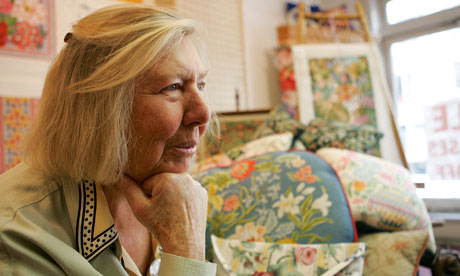
Erica Wilson, who has died after suffering a stroke aged 83, was an unlikely public presence in the US, a posh-voiced Briton with needle in hand, on a mission to repopularise handicrafts in mechanised, industrialised America. For over 60 years, she proselytised through books and on television. Her series was filmed in the studio next to the one where Julia Child taught America to cook; Wilson shared some of Child's enthusiastic style and all of her ambition to demystify and democratise what had become arcane skills.
Wilson never considered needlework an elite occupation, recalling that, aged about six, she had experimentally stitched a crinolined lady, with yarn stolen from an aunt. The daughter of an army officer, she was born in Tidworth, Wiltshire, and enjoyed sewing lessons in the Scottish and English schools of her wandering childhood. Her mother suggested that embroidery was her metier, and that she should study at the Royal School of Needlework in London. Wilson was so gifted a pupil that she became a teacher. She would have stayed there, restoring robes and embellishing church vestments, had she not been recruited in 1954 by an American who intended to set up a school of needlework in New York State.
Wilson sailed across the Atlantic on a year's contract with a trunk of wool threads "thinking I was going to Indian country, where such things wouldn't be available". They were, and anyway Wilson was an inspired improviser. She found on the other side first hundreds, then thousands, of housewives, returned to the home after the second world war, condemned to leisure in their easy-to-run kitchens, and all longing to learn classy accomplishments.
She taught at the Cooper-Hewitt (New York's national design museum) and in her Manhattan apartment for a measly $3 an hour; her mimeographed diagrams for learners became the basis of a correspondence course. Her vocation began to bring in an income. At a fancy dress ball (naturally she had made her own costume) she met the furniture designer Vladimir Kagan. Their courtship developed as she embroidered him a waistcoat, and they married in Woodstock, New York, in 1957.
Although that predated Woodstock's festival, Wilson always described herself and Kagan as hippies, and, later, as old hippies, following their bliss through life, with success and money just agreeable byproducts. When it came to the real hippy era, Wilson loosened up and emboldened her approach to design and technique, to encourage a younger generation of women (and a few men) who took to embroidery as self-expression and as defiance of a machine-made consumerscape. She sold canvases printed with her designs (many adapted from wonders in Manhattan's museums, including the medieval unicorn tapestries in the Metropolitan), and the wool to work them, an easy, repetitive activity more soothing than narcotics.
Acres of Wilson needlepoint covered the surfaces in American houses; she gave instructions and inspiration for embroidery via her television programmes (shown on the BBC in the UK, and in Australia), using anything that could be threaded in a needle or that a needle could pierce – chunky double-knitting wool stabbed through sacking for wallhangings big as subway posters, for instance.
Of her many publications, all bestsellers, Embroidery Book (1973) and Needleplay (1975) remain manuals on a par with Thérèse de Dillmont's definitive 19th-century craft encyclopedia. At its zenith in the 1970s, Wilson's corporation grossed a million dollars a year and she commanded high fees for personal appearances, including lectures on needlework cruises – an expensive week of sailing and stitching.
In 1972, Wilson opened a shop on the Upper East Side of Manhattan, a shrine for embroiderers for the next 33 years, until commercial rents tripled and a well-publicised fashion for knitting, backed by big brands promoting novelty yarns, displaced embroidery in the precious few free hours left to working women. Her shops in Palm Beach and Long Island went too, leaving only a retail outlet on Nantucket and a prosperous website, which also sold her clothes.
Kagan and Wilson raised their family in the New York apartment where they lived for 40 years, its 10 rambling rooms enriched by their art collection, his furniture and her needleworks. Visiting crafters were awestruck to encounter the much-photographed Kagan rocking chair Wilson had embroidered with owls in a tree back in the 1970s, and were even more impressed when they sat in it, as its stitchery, in rug wool thick as string, indented their behinds. The couple continued their combative, devoted collaboration on new pieces right up until her death.
Kagan survives her, along with their two daughters, Vanessa and Jessica, and a son, Ilya.
• Erica Moira Susan Wilson, needlewoman, born 8 October 1928; died 13 December 2011

